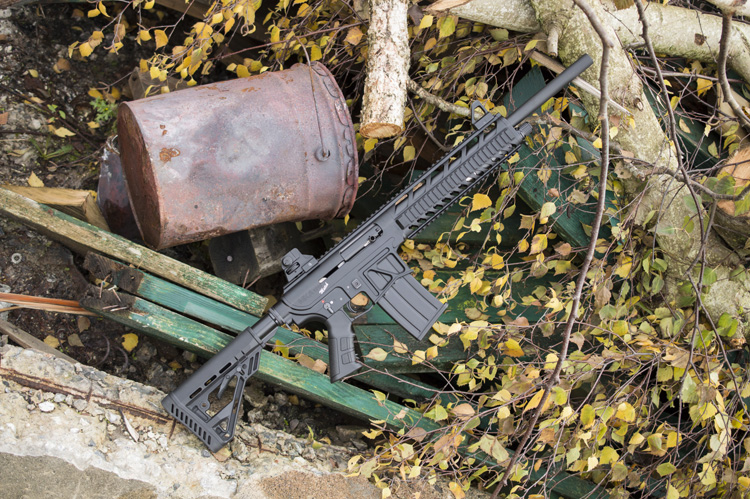
Yes. It’s another box-fed tactical shotgun. Yes. It’s another box-fed tactical shotgun made in Turkey. If you don’t care to read beyond that, we understand; 2016 has been the year of the Turkish tactical shotgun. But, given this is our final issue of the year, we thought we’d end the year discussing one of the more interesting Turkish tactical shotguns to find its way to Canada this year: The MKA 1919 Match.
So what is the MKA 1919 Match? Well, it’s a gas-operated, box magazine-fed tactical or competition shotgun, constructed in the now-familiar upper/lower receiver fashion. Like many of the other Turkish semi-auto shotguns, the upper receiver fits over a protruding lip at the fore of the lower receiver, but unlike many of the other guns this one requires tools to take down. There’s a small bolt under the rear of the upper receiver that holds the two halves together. Given the manual cites potentially using a rubber mallet to separate the receivers, we expect it’s not a task to be undertaken all that frequently.


Otherwise, there’s plenty of additional features that generally form the meat and potatoes of these sorts of guns; there’s a pair of QD sling mounting points on either side of the three-position adjustable stock. An additional sling swivel lives on the gas system cap that retains the handguard. A single-point sling hook point is affixed to the lower receiver extension for those shooters that feel like having their knees beaten on by their shotgun muzzle. The pistol grip mimics that of an A2-style AR grip. It’s all very “tactical.”
But if all this is sounding quite conventional, we would draw your attention to the left side of the handguard. There, you’ll find a non-reciprocating charging handle. Yes indeed, this shotgun does have a plurality of charging handles: One reciprocating handle firmly attached to the bolt like all semi-auto shotguns have, and a second non-reciprocating charging handle on the left side of the barrel assembly. This second handle operates the action by interfacing with the collar aft of the gas piston. Pulling this charging handle rearward essentially simulates the gas system operating the shotgun, albeit without the gas piston itself moving. Push the handle forward, or allow the action spring to push it home, and a spring loaded detent holds the changing handle in place.

In order to test the MKA 1919 Match’s performance in that sort of setting, we took a variety of relatively light target loads and a few slugs out to the range to see how it performed. One thing was immediately obvious: Being pretty well versed in the AR-15’s manual of arms certainly helped us with the MKA 1919 Match. Where conventional semi-auto shotguns force you to retrain loading techniques, ammunition storage and access, and control systems, the MKA loads, handles, and shoots pretty much like an AR-15.

However, no such simple fix could be found for the sights. The factory iron sights fitted to the MKA 1919 are terrible. In case you were wondering, they are aluminum (with the exception of the windage adjustment knob), but any points they gain for being stout they lose for being bad. First off, the front sight is an all-milled unit so there’s no adjustment there, nor any ability to screw in other AR-15 front posts. But the rear sight’s the real problem. First off our windage knob was on crooked, and it’s spring-loaded detent ball didn’t work, so it had no clicks nor retention of adjustment. Furthermore, the rear sight is a mix of rifle and pistol sights, with a small AR-15-like rear peep sight that can be flipped over to utilize a notched sight like one would find a pistol. Neither of these are shotgun sights. And, since our windage detent didn’t work, swapping from peep sight to notched sight adjusted the windage. Save yourself the headache; buy a red dot and take the sights off entirely.

We need to mention the magazines as well, because one of the key components in any box magazine-fed shotgun is the magazine. In fact, most box magazine-fed shotguns exhibiting reliability problems can probably trace the majority of the problems back to the magazine. Like .22 LR rounds, 12-gauge hulls are rimmed, which when combined with their huge diameter, makes them very problematic to load smoothly. The MKA 1919 Match obviously never demonstrated any problems loading rounds from the magazine to shotgun, so in that sense they’re very reliable, but with some very stiff follower springs it did take some practice before we could load the magazines with shells without struggling. But they’re great magazines, with steel bodies, bright orange followers to make an empty gun even more obvious, and polymer floorplates. And yes, these beefy mags do drop free.

And it works. And it works quite well. With the unique double charging handle setup it’s incredibly versatile. In fact, that’s one of those features we’re looking at and saying “why didn’t anyone think of this sooner?” It just makes sense. And with the 5-round mags facilitating easy and rapid magazine changes, we can see it being very popular among competitors taking part in longer courses of fire, and those that may need to revert from shot to slug and back again… if you can remember to drop the mag and replace it before you address the last target requiring whatever ammo was in the old magazine!
